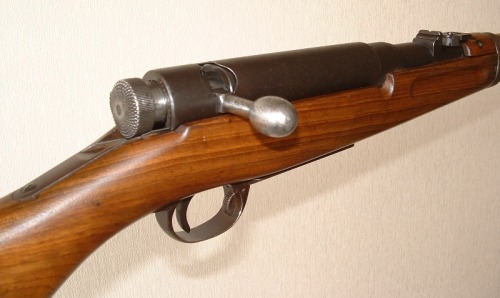The Japanese Type 38 Arisaka,The original Arisaka, the Type 30, served the Japanese Empire from 1899
The Japanese Type 38 Arisaka,The original Arisaka, the Type 30, served the Japanese Empire from 1899 to around 1906. However the Type 30 was a flawed design which suffered from serious malfunctions such as case ruptures, misfires, jams, difficulty in cleaning, and difficulty in case extraction. In the year 1905, the famous Japanese gun designer Kijiro Nambu was tasked with a complete redesign of the Arisaka action. Nambu strengthened the Arisaka action and replaced the extractor with a more reliable mechanism. He also simplified the action, reducing it from 9 working parts to six, and designing it in such a way that it required no tools for field stripping, much like European counterpart Mausers. What resulted as an especially accurate and tough rifle, in fact tests conducted by gunsmiths, gunwriters, US Army Ordnance, and the NRA would prove that it was the strongest action of all other bolt action military rifles of the era.The new rifle was introduced in 1906, called the Type 38 as it was the 38th years of the Meiji Emperor’s reign. While the Type 38 was a redesign of the Type 30, the most noticeable difference was outward in nature; the stamped metal dust cover which enveloped the action and chamber. The purpose of the dust cover was to protect the action from dust, dirt, mud, and other detritus. However, most soldiers found the addition not only useless, but detrimental as the covers would rattle and make a lot of noise. Most Japanese soldiers simply pried the dust cover off and threw them away, Regardless, a dust cover would become a standard feature of all Japanese bolt action rifles thenceforth.The Type 38 served the Japanese Empire primarily in the 1920’s and 1930’s as it invaded China and began to expand throughout the Pacific. One of the most common complaints of the Type 38 was that it was underpowered, firing a 6.5x50mm cartridge. In 1939 the Type 38 was to be replaced with the Type 99, which used a larger and more powerful 7.7x58mm cartridge. However the Japanese Army had over 3 million Type 38 rifles and carbines in service or in arsenal, and it was loathe to simply dispose of so many working rifles. Hence the Type 38 was issued concurrently with the Type 99 in almost equal numbers. Its use with the Japanese military would end with Japan’s surrender in 1945. Many made their way to the United States as either war trophies or military surplus. They are popular items for historical firearms collectors today. -- source link
#guns#firearms#rifles#history#bolt action#arisaka#japanese history#wwii



